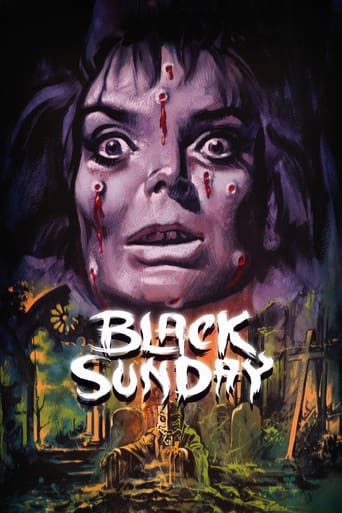STARE INTO THESE EYES...Discover deep within them the unspeakable, terrifying secret of BLACK SUNDAY...It will paralyze you with fright!
"La maschera del demonio," released in 1960 and produced by Galatea Film and Jolly Film in Italy, is a seminal work in the horror genre, directed by the visionary Mario Bava. The film, also known internationally as "Black Sunday," marks Bava's directorial debut and showcases his mastery of atmospheric tension and visual storytelling. The plot revolves around the vengeful spirit of a witch, Princess Asa Vajda, who is resurrected after her tomb is disturbed, seeking to exact revenge on the descendants of those who condemned her to death. Bava's use of striking imagery, particularly the iconic spiked mask that is hammered into Asa's face, sets a chilling tone that has influenced countless horror films that followed. The film's narrative is steeped in gothic horror, drawing heavily on themes of witchcraft, resurrection, and cursed lineage. The character of Princess Asa, portrayed with haunting intensity by Barbara Steele, becomes a symbol of malevolence and beauty intertwined, captivating audiences with her dual nature. Steele's performance, combined with Bava's meticulous direction, creates a palpable sense of dread that permeates every frame. The film's setting in a gloomy, fog-laden Eastern European village adds to the eerie atmosphere, making the supernatural elements feel disturbingly plausible. "La maschera del demonio" also stands out for its technical achievements, particularly in the realm of cinematography. Mario Bava, who also served as the film's cinematographer, employed innovative techniques such as the use of shadows and light to craft a visually stunning experience. The film's opening sequence, featuring the brutal execution of Asa and her lover Javutich, is a masterclass in horror filmmaking, utilizing close-ups and dramatic lighting to heighten the impact of the scene. Bava's ability to create suspense through visual means alone is a testament to his skill and foresight in the genre. Despite facing censorship and controversy upon its release, "La maschera del demonio" has endured as a classic of Italian cinema and a cornerstone of the horror genre. Its influence can be seen in the works of directors like Dario Argento and Tim Burton, who have cited Bava's film as a significant inspiration. The film's blend of gothic horror, psychological tension, and visual artistry continues to captivate audiences, cementing its place in the annals of cinematic history. "La maschera del demonio" remains a testament to Mario Bava's genius and a haunting reminder of the power of horror to both terrify and enchant.
年1960
上映時間86 分
ジャンルホラー
製作国Italy
